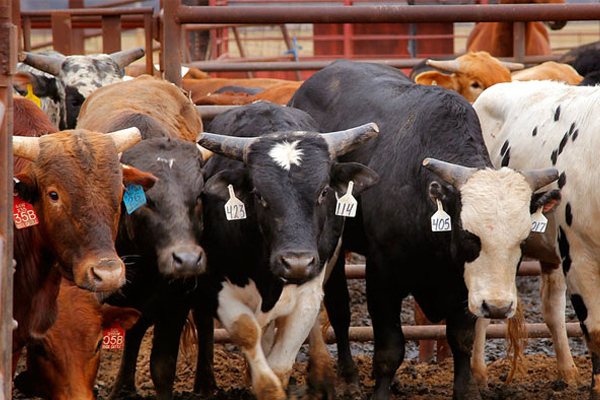March 6th 2024
Preliminary data on the environmental impact of U.S. cow hide production, calls for rethink on leather, Economist Sustainability Week Summit is told.
- Life Cycle Assessment aids businesses with decision making that supports the planet
- Full transparency in data sourcing, methodology and assessment with peer review
- Higg Index overestimated U.S. hide’s impacts
- Grass finished and grain finished cattle differ in environmental footprint
London; 6 March 2024 - A comprehensive Life Cycle Assessment (LCA) of U.S. cow hide production has found the environmental footprint of leather to be significantly less than previously reported by the Higg Index, the Economist Sustainability Week Summit heard today.
The independent study was funded by the Leather and Hide Council of America (L&HCA) on behalf of the leather industry. It was conducted by Greg Thoma, Ph.D., Director of Agricultural Modeling and Life Cycle Assessment for the AgNext program at Colorado State University.
In its first phase it drew on data from across the U.S. industry to calculate a whole cow footprint for dairy and beef cattle, both range finished and feed finished, and then considered the allocation of burdens to hides. The latter includes hides produced from both dairy and beef cattle. Approximately 95% U.S. hides are exported either as raw hides or wet blue, a first stage tanning process, and finished overseas.
Production of cattle hides can be the most significant environmental impact of leather. The study found that greenhouse gas emissions caused by the use of cattle hides was significantly less than that stated by the Higg Index, which is often used by brands and manufacturers to evaluate the environmental impact of materials.
Kerry Brozyna Acting President, Leather & Hide Council of America, said:
“As representatives of the U.S. Leather Industry we strive for continuous improvement in the processes for using an incredibly resilient material provided to us from the meat industry, and to ensure accuracy in data related to the use, quality, and sustainability of Leather.
When the study is completed, we will publish our modelling and share inputs and results. Our desire is to provide scientifically tested information to our stakeholders so they can make the best decisions for their consumers, their businesses and the planet.”
Life cycle assessments are an important lens to effective interventions that can lead to reductions in the environmental impact of production. Data transparency is critical to verifiably accurate assessments. The study’s first phase drew two main conclusions. First, there has been a lack of data transparency and a serious overstatement of the relative environmental impact of cattle hide and leather.
Second that animal husbandry practices do impact the overall footprint of leather production. Grass fed cattle tend to have a slightly higher carbon footprint than feed finished cattle because grass fed cattle take longer to reach slaughter weight. Feed finished cattle tend to have a slightly higher carbon footprint than dairy cattle because normally there is a significant allocation to the milk product from the dairy.
Speaking at the Economist Sustainability Week summit, Kevin Latner, Vice President, Sustainability, Leather & Hide Council of America commented:
"We were pleased to see that processing of hides, a natural waste material, delivers a low carbon footprint. The new data shows that leather can be a renewable, sustainable material and suggests that is better for the environment than oil-derived synthetics.
“It also shows the challenges and opportunities ahead for the textile industry in pursuit of our shared environmental goals for the planet. The industry needs to publish credible and transparent data to inform discussions, to understand supply chain issues and to enable businesses and consumers to make informed purchase decisions with standard metrics. All materials need to follow best practice in environmental impact assessment. We need to do better.”
Impacts calculated in the Life Cycle Assessment included water use, eutrophication, greenhouse gas emissions, toxicity to humans, ozone depletion and the impact of the release of chemicals into fresh water, sea and on land to ecosystem health.
While the data underlying the Higg Index is not available, the methodology and environmental impact category results are available, albeit behind a paywall. Comparing the Higg Index impact category reveals that greenhouse gas emissions, eutrophication, water scarcity and fossil use over estimates the hide's contribution to leather. (See appendix one for comparison graphs.) The graphs/tables show a comparison U.S. hide allocation to leather based on four environmental impact categories, including greenhouse gas emissions, eutrophication, water scarcity and fossil resource use, and the equivalent extracted from the Higg Index website.
Cattle and leather producers, including U.S. producers, have recently made notable improvements to their environmental impact. Technological advances, policy changes, consumer demands and corporate social responsibility goals have all driven these improvements. One of the main purposes of this life cycle assessment is to calculate the footprint of leather at all stages in its manufacture in order to allow producers to identify areas for improvement.
The final report will be available April 2024 and subject to expert panel review.
Notes for editors:
Goals:
The specific goals of this project are the following:
- Perform an ISO 14040/4044 conformant life cycle assessment of leather production, from cradle to tannery gate, evaluating a variety of animal husbandry systems and alternate approaches for multifunctionality in the supply chain.
- To support internal marketing decisions. This is a full report subject to external expert panel review.
Greg Thoma, LCA lead
Greg Thoma, Ph.D. is the Director of Agricultural Modeling and Life Cycle Assessment for the AgNext program at Colorado State University. He is leading efforts at stakeholder engaged, experimentally verified, model development for sustainable animal agriculture systems. Dr. Thoma served on the steering committee from 2014-2019 on the Swiss National Science Foundation’s National Research Program titled, “Healthy Nutrition and Sustainable Food Production” that has the goal of promoting healthy nutrition through a safe, high quality food supply, available in sufficient quantity at affordable prices, while minimizing environmental impacts and fostering efficient resource utilization. Read more here.
Data:
The life cycle inventory (LCI) data were derived primarily from a process model, the Integrated Farm System Model (IFSM), peer-reviewed literature, government statistics and commercial and open-source LCI databases.
Best Practice:
The Leather & Hide Council of America believes that best practice in textile assessment - if the aim is to enable informed purchasing decisions - requires four key criteria to be met:
- That data sourcing and use is transparent, trusted and open to scrutiny
- That models and their outputs are peer reviewed, open source, and frequently updated
- That methodologies and data are usable to compare equivalent products
- That all studies offer equivalent cradle-to-grave metrics
ABOUT THE LEATHER AND HIDE COUNCIL OF AMERICA
The L&HCA was established to promote the U.S. leather industry and represents the interests of 75 member companies across the leather supply chain. A full-service trade association, L&HCA provides its members with government, public relations and international trade assistance and support. The association is also a co-operator organization under the U.S. Department of Agriculture's foreign market development programs, furthering opportunities for U.S. agricultural exports. For more information visit usleather.org




